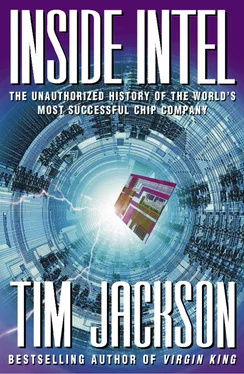As the problem escalated, Intel’s response had been doggedly consistent. The company had kept repeating that the flaw was unimportant, and kept insisting that it required no corrective action from most owners of computers equipped with a Pentium chip. Intel had admitted that a small number of specialized users, mostly scientists or mathematicians, might need their Pentiums replaced. But Andy Grove, the company’s combative chief executive officer, insisted that the people best equipped to decide who was in this category were Intel’s own engineers. As a result, customers who wanted to return a flawed Pentium would have to call Intel and convince the company that they really needed a replacement.
Intel’s approach to the issue had the support of the computer industry. The last thing that makers and retailers of PCs wanted was to be put in a position where they had to open up hundreds of thousands or even millions of PCs already in the distribution channel on their way to end-users, and go through the time-consuming and expensive business of replacing their existing processors with new ones. So the industry, which understood from experience that no microprocessor was ever perfect on first launch, stood staunchly behind its leading chip manufacturer. Company after company issued press releases telling customers that the Pentium flaw was nothing to worry about, and Intel’s approach to the problem was just fine.
That wasn’t how the general public saw the issue. Inflamed by critical comments on the Internet, newspaper readers and TV viewers couldn’t understand why a maker of microprocessors should be any different from the rest of manufacturing industry. If you were in any other business and discovered a major problem with one of your products, you offered customers a free exchange, no questions asked. It was as simple as that. You didn’t screw them around by telling them the problem probably wouldn’t affect them and force them to call you and jump through hoops before they could get a replacement. Yet that was what Intel seemed to be doing – and its attitude seemed to be brazenly arrogant, since the problem with its new chip, advertised as the latest and greatest in computer technology, was a simple one: it couldn’t do long division properly.
For a few uneasy weeks the alliance of expert insiders had succeeded in defying the instincts of the less well-informed outsiders. It had looked as though Andy Grove’s boldness and willingness to take criticism and unpopularity would eventually triumph. The chorus of complaints against Intel had begun to die down, and consumers had seemed to be getting the message that the Pentium flaw wasn’t such a big deal after all.
But the situation was precarious. It depended on the giants of the computer business maintaining complete unanimity. If just one major vendor changed sides, then it would no longer be possible for Intel to convince its customers that all the experts agreed there was no problem.
That change had now happened. International Business Machines, the computer giant that had unwittingly helped Intel rise to dominance of the industry, had broken ranks. For reasons that Intel had not been able to fathom, the company had put out an announcement saying that it was putting shipments of new machines equipped with Pentium chips on hold until the issue was resolved.
The result was pandemonium as Intel’s customer-support lines were flooded with anxious callers. A new round of criticism was unleashed in the media. Finally, the company was forced to face one of the toughest decisions of its history. Should it guarantee to exchange all the flawed chips – even for customers who used their computers for nothing but playing games – and face up to wasting half a billion dollars on an unnecessary returns programme? Or should Intel stick to its guns? Should it save some money in the short term, but run the risk of throwing the computer industry into turmoil and causing long-term damage to the value of its brand?
This, Gordon Moore explained, was the question that Intel’s board now had to decide.
Maybe Arthur Rock should sit down after all.
The decision the Intel board took that day was undoubtedly the right one. Reversing completely its former position, the company announced that it would now offer a no-questions-asked exchange to anyone who owned a flawed Pentium. Andy Grove issued a grovelling public apology for the irritation that his previous stance had caused, and the company set up an emergency call centre to handle the expected rush of customers dialling in to take up the offer. To cover the costs of the incident, the company set aside $475m – more than half its earnings during the last quarter of 1994, when the board meeting took its decision – and turned one million of the world’s most advanced microprocessors into nothing more than ornamental tie-pins and key chains.
Once Intel had backed down, the bad publicity went away almost instantly. Within weeks, public confidence in the corrected Pentium chip began to return. Within months, the two class-action lawsuits that had been filed against the company as a result of the Pentium flaw began to move to settlement. And Intel, scarred and chastened by the experience, began to return to the business it knew best: building microprocessors for personal computers.
Today, three years later, the incident has been forgotten by most people other than specialists in the microprocessor industry. Intel’s brand is stronger than ever, and its share price has nearly quadrupled since that telephone board meeting. In retrospect, the Pentium incident now looks like an aberration, a buying opportunity, a hiccup in the otherwise irresistible rise of one of America’s most powerful and successful companies.
But was it an aberration? Or did the Pentium scandal reveal something important about Andy Grove and the company that he ran?
Intel Corporation, founded in 1968, can claim credit for inventing some of the most important technologies of the modern electronics industry and bringing them successfully to the mass market. Towering among its achievements is the invention of the microprocessor, which has brought the power of computing to the desks of hundreds of millions of people all over the world, and has changed the world around us by putting intelligence into appliances ranging from vacuum cleaners to cell phones and from toys to cars.
The conditions that gave rise to this extraordinary spike of scientific innovation were put in place by two men, Robert Noyce and Gordon Moore. Both of them were leading figures in California’s electronics industry, long before the San Francisco Bay Area even became known as Silicon Valley. It was their charisma, their leadership, their contacts and their reputation that brought together a group of the most talented engineers in the world and established the framework that allowed scientific creativity to flow.
But it was only for a short time that innovation was the most significant thing that Intel did. When it released the world’s first microprocessor to the market, Intel was just two years old, and had been a public company for only one month. It did not yet stand out far from the crowd of other startup companies trying to make money from the uncertain new technology of integrated electronics.
So Intel changed. From being just an innovator, it became a company whose objective was to deliver – to make sure its good ideas were turned into practical products that customers could use, products that arrived on schedule and at prices that fell consistently year by year. This transformation was no mean feat. It forced Intel to become rigorously organized and focused, and to find a balance that allowed it to keep firm control over its operations without jeopardizing the creativity of the scientists who were its greatest commercial asset.
Читать дальше








![Chade-Meng Tan - Search Inside Yourself - Increase Productivity, Creativity and Happiness [ePub edition]](/books/703803/chade-thumb.webp)
